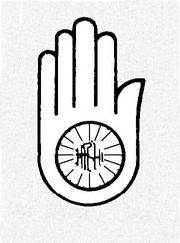Jainism

The Jains
Even before the coming of the Buddha in the sixth century BCE, wandering ascetics had begun to reject the Vedas and the orthodox priesthood of the brahmans. They wanted release from the bonds of samsara by renouncing worldly possessions and practicing asceticism. Sometimes called shramanas (a word from which “shaman” probably derives), they felt that the act that created the most karma was violence, and so they devoted themselves to the practice of (“non-harming”). The growth of this principle in Indian belief eventually ended animal sacrifice and led almost all Hindus to practice vegetarianism to some degree or other.
These heterodox believers — who challeneged the orthodox belief system of the day — eventually created other religions. The most successful, of course, has been Buddhism, but some others also sprang up around the same time. One was founded by a close contemporary of the Buddha and came to be known as the Jains, or Jainas. Jains are followers of a Jina or Tirthankara — literally, one who provides a path across the water (of ignorance). There had been 23 jinas stretching back millennia; the 24th and last was Mahavira, who founded Jainism in the sixth and fifth centuries BCE. He had been preceded by Parshva by as much as 250 years, and many Jains today think of him as their true founder. Like the Buddha, Parshva was raised in a palace but left it to pursue the ascetical life. And, like Buddhism, Jainism doesn’t believe in a Supreme Being but in achieving liberation of the soul, or jiva, by individual effort that mainly involves ascetical practices.
Jains believe that souls pass through many stages of transmigration, during which they become trapped in plants, animals, insects, stones, earth, air, and fire, as well as human bodies, and even exist in microscopic water bodies. Because of this belief, Jains hold that violence and killing, of animals and even insects, is evil. Jains accept many other aspects of the Hindu worldview, such as reincarnation and samsara. But Mahavira believed that every living being, or soul, is bound by karmic mater — tiny, invisible particles similar to atoms — that are accumulated by good or bad deeds, violent acts or emotions. Under the influence of karma, the soul seeks pleasure in material possessions, which in turn are the deep-seated cause of anger, hatred, greed, and other vices that accumulate more karma.
In most other ways, Jains view the cause-and-effect nature of karma much as Hindus and Buddhists do. But since they see bad karma resulting from even unintentional acts of violence — accidentally harming insects or water bodies — which can sometimes lead to inaction. Their strict observances and denial of sensuality under almost any circumstances may have contributed to their relatively small numbers in the world today. There are about five million Jains in the world today, making it one of the smallest world religions, somewhere between the Baha’i Faith and Shinto.
To achieve liberation from the bondage of karma, Jains take five great vows:
- Nonviolence (Ahimsa) — to cause no harm to any living beings;
- Truthfulness (Satya)
- Non-stealing (Asteya)
- Chastity (Brahmacharya) — not to indulge in sexual activity
- Non-attachment (Aparigraha) — complete detachment from people, places, and material things.
Although all Jains hold these vows, Jain monks and nuns follow them strictly and totally. Lay people try to follow the vows insofar as their lives permit. They also emphasize asceticism, and some have undertaken a holy death fast — an extreme that distinguishes Jainism from the Middle Way of Buddhism.
Awakening, or kevala, begins with a momentary vision of the true self, achieved through study and faith in the teachings of the Tirthankaras, with a strong emphasis on philosophy and reasoning. Although Buddhists and Hindus practice ahimsa, none do it with the thoroughness of the Jains, whose monastic communities are known to carry small brooms to sweep the path in front of them lest they unknowingly crush small insects, to wear face masks to avoid breathing in insects, and to eschew swimming or bathing so as not to injure invisible water bodies.
Jain Sacred Texts
A major schism occurred among the Jains around the time of Mahavira’s death. The Digambaras, like Mahavira, practice total nudity to avoid all attachments. The Shvetambaras reject nudity as an exterior symbol having no significance on their inner spiritual development. They also accepted women into the monastic community early on, unlike the Digambaras.
The chief sacred texts of the Jains are the 11 Angas (“limbs”) compiled by Indrabhuti, plus the 12 Upangas (“secondary limbs”), and the Uttaradhyayana Sutra. Jaina scriptures are considered to be the teachings of enlightened men, but not the revealed word of God.
Because of their extremely strict adherence to vows against lying and stealing, Jains are highly regarded in India as business people of the utmost integrity. As a result, they have become very successful and influential in commerce. The roughly three million Jains in India today share a disproportionate amount of the country’s wealth.


